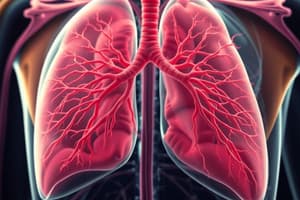Podcast
Questions and Answers
What is the primary function of the circulatory system?
What is the primary function of the circulatory system?
- Breaking down food into absorbable molecules
- Transporting essential nutrients, gases, and waste products (correct)
- Facilitating gas exchange in the lungs
- Regulating the temperature of the body
Which structure is primarily responsible for gas exchange?
Which structure is primarily responsible for gas exchange?
- Larynx
- Bronchi
- Trachea
- Alveoli (correct)
What is an example of a specialized cell and its main function?
What is an example of a specialized cell and its main function?
- Epithelial cell - protects underlying tissues
- Muscle cell - transports oxygen
- Nerve cell - transmits signals (correct)
- Blood cell - absorbs nutrients
Which process is essential for the breakdown of food in the digestive system?
Which process is essential for the breakdown of food in the digestive system?
Which phase is NOT part of mitosis?
Which phase is NOT part of mitosis?
What role do blood vessels play in the circulatory system?
What role do blood vessels play in the circulatory system?
Which component of the respiratory system is crucial for ventilation?
Which component of the respiratory system is crucial for ventilation?
Which essential function is attributed to muscle cells?
Which essential function is attributed to muscle cells?
Flashcards
What does the circulatory system do?
What does the circulatory system do?
The circulatory system is the body's transportation network, carrying essential nutrients, gases, and waste products.
What is the role of the heart?
What is the role of the heart?
The heart is the central pump of the circulatory system, propelling blood throughout the body.
What does blood transport?
What does blood transport?
Blood carries oxygen, nutrients, and hormones to cells and removes waste products like carbon dioxide.
What is the main role of the respiratory system?
What is the main role of the respiratory system?
Signup and view all the flashcards
What are the lungs responsible for?
What are the lungs responsible for?
Signup and view all the flashcards
What are specialized cells?
What are specialized cells?
Signup and view all the flashcards
What is mitosis?
What is mitosis?
Signup and view all the flashcards
What is the function of the digestive system?
What is the function of the digestive system?
Signup and view all the flashcards
Study Notes
Circulatory System
- The circulatory system transports essential nutrients, gases, and waste products throughout the body.
- It comprises the heart, blood vessels (arteries, veins, capillaries), and blood.
- The heart pumps blood, propelling it through the circulatory system.
- Blood carries oxygen, nutrients, and hormones to cells, removing carbon dioxide and waste products.
- Blood vessels regulate blood flow to different parts of the body, ensuring adequate resource delivery.
Respiratory System
- The respiratory system facilitates gas exchange—taking in oxygen and releasing carbon dioxide.
- Key structures include the lungs, trachea, bronchi, and alveoli.
- The lungs are the primary organs for gas exchange, where oxygen diffuses into the bloodstream and carbon dioxide diffuses out.
- Ventilation (breathing) moves air in and out of the lungs, creating the pressure difference needed for gas exchange.
- The respiratory system is crucial for maintaining the body's oxygen levels for cellular respiration.
Specialized Cells
- Specialized cells have unique structures and functions.
- Different cell types suit various tasks, like muscle cells for movement, nerve cells for signal transmission, and blood cells for oxygen transport.
- Specialized cells form tissues, working together for complex functions.
- Cell specialization is essential in multicellular organisms.
Digestive System
- The digestive system breaks down and absorbs food.
- It includes the mouth, esophagus, stomach, small intestine, large intestine, and accessory organs like the liver and pancreas.
- Mechanical digestion breaks food into smaller pieces.
- Chemical digestion uses enzymes to break food into absorbable molecules.
- Nutrients are absorbed through intestinal walls, entering the bloodstream for cell distribution.
- Waste products are eliminated from the body as feces.
Mitosis
- Mitosis produces two genetically identical daughter cells from a single parent cell.
- It's essential for growth, repair, and asexual reproduction in multicellular organisms.
- The process involves prophase, metaphase, anaphase, and telophase.
- During prophase, chromosomes condense and become visible.
- In metaphase, chromosomes align in the middle of the cell.
- During anaphase, sister chromatids separate and move to opposite poles.
- Telophase involves the cell division into two daughter cells.
- Mitosis ensures each new cell receives a full set of chromosomes.
Studying That Suits You
Use AI to generate personalized quizzes and flashcards to suit your learning preferences.
Description
Test your knowledge of the circulatory and respiratory systems in this quiz. Explore how these systems work together to transport nutrients and facilitate gas exchange in the body. Understand the key structures involved and their functions.



